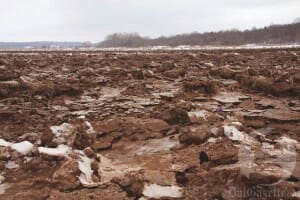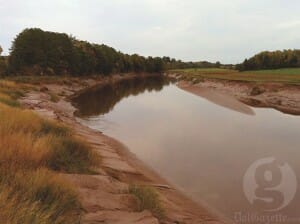
Go with the flow
Nova Scotia is looking to renewable energy sources.

Ice blocks (such as the one pictured above) could possibly damage turbines in the Bay of Fundy. Photo by CarolAnne Black
Nova Scotia is looking to renewable energy sources. For most of the world, renewable energy means hydroelectric, solar and wind energy. But here in Nova Scotia, it can mean the tides.
Soon we may be using in-stream tidal turbines as a form of renewable energy. But nowhere else have turbines been exposed to tides as big and powerful as the ones found here.
The world record tidal range was set in 1916. Measuring just over 16m, it was about the height of a five-storey building. The location was Burntcoat Head, NS, a part of the Bay of Fundy that runs along the south shore of the Minas Basin.
Because the Bay is in Canada, it must contend with our winters. When below freezing temperatures set in, the cold combines with the record-setting tides and muddy waters to form brown ice blocks.
It is these blocks that pose the biggest threat to tidal energy research in Nova Scotia. If we are going to adopt tidal energy as one of Nova Scotia’s forms of renewable energy, we must first understand how these ice blocks could impact turbines in the Bay of Fundy.
Fundy ice blocks are formed in rivers connected to the Bay and are often swept along by high-water tidal currents, beaching at a new home in each low tide. Blocks can accumulate mud until they barely float or just barely sink.
It is well known that ice blocks set adrift can collide with surface structures, such as wharfs and bridge footings, but what about the ice we can’t see from above the water’s surface?
In 2009, Nova Scotia Power and its partner OpenHydro tested a tidal power turbine at the bottom of the Minas Basin. The tidal currents in the Basin are immense sources of renewable and predictable energy. (Solar and wind are renewable, but inherently unpredictable.)
To decrease the water level from high to low tide, currents flush from Fundy roughly the same volume of water as the discharge into the ocean of all the world’s rivers combined. Four times daily, during two tidal cycles, this exchange of water occurs between the Atlantic Ocean and the Bay of Fundy. But extraction of energy from the Bay could create complications from collisions between bottom-anchored tidal power generators and sub-surface ice blocks.
Nova Scotia Power and the Natural Sciences and Engineering Research Council of Canada (NSERC) are funding research at Dalhousie to investigate the threat posed by these ice blocks. One of the first questions to answer is how the ice blocks form. It turns out the key to answering that is Fundy’s unique tides.
The oceans are affected by the gravitational pull of the moon and the sun. Their combined forces cause the tides. But the worldwide average tidal range is a little less than one meter. It’s mostly the shape of the Bay of Fundy that makes its tides super-sized.
The Bay narrows from 120 km at its mouth into two basins—Chignecto Bay and Minas Basin—both of which slowly restrict and end in tidal mud flats and rivers. The water entering the Bay with the incoming tide must go somewhere, and the only place to go as the Bay constricts is up.
The Bay is also subject to tidal resonance. Like a boy on a swing, if pushed with the right timing when he slows at the back of the swinging motion, he will go higher. The same is true of tides in the Bay. The motion of the Earth, sun, and moon push the tides in the Bay with the right timing, and the tides nearly resonate, making them go higher.
Together, the narrowing from the mouth of the Bay and the timing for resonance give Fundy its huge tides.
To get muddy ice blocks, it’s only necessary to throw in some mud.
The water in the Minas Basin and Chignecto Bay is chocolate milk brown. Tidal currents erode mud from the bottom and sides of the Bay, enough so to make the water opaque. In the winter, the mud is incorporated into ice as it forms. In just a few days or weeks of cold weather, vast amounts of ice can form in the Bay and in river channels connected to the Bay. The ice forms as frazil ice: microscopic pieces of ice that develop on the surface and on the bottom. Most of the ice ends up floating on the surface and makes a slushy layer called grease ice.
With each high tide, the chocolate slush floats up onto the banks of river channels and gets frozen to previous layers of frozen slush and ice, building up vertical ice shelves. When the ice shelves become unstable they can fall into the river, making ice blocks that are flushed out of river channels and into the Bay by tidal currents.
In a 2008 report to The Fundy Tidal Energy Technical Advisory Group and The Ocean Energy Environmental Research Association, three of 10 samples of ice blocks collected were found to sink when immersed in fresh water.
In the current Dalhousie study, results from winter 2011 showed that two of 13 block samples sunk. It is hoped that results from studies conducted over winter 2012 will lead to an understanding of the quantity of blocks that may be formed in the Bay and the fraction of those that may not float at the surface of the water.
Soon we may be able to predict the yearly quantity of blocks that are formed around the Bay, where they form, and when they are likely to be in the open water of the Bay. Researchers at Dalhousie are also working on other components of this project: using acoustics, we can look through the murky water to locate blocks as they head toward turbines; by tracking blocks in the water and melting samples in the lab, we can find melt rates to see how quickly the blocks melt in open water; and by testing the strength of the blocks, we can find how damaging they could be to man-made structures. The results of this project will help those who design and implement tidal power generators understand the threat posed by the blocks.
By 2020, Nova Scotia is targeting 40 per cent of the province’s energy to come from renewable sources. Tidal power may be part of reaching that goal.
Locally, more students and researchers should be funded to study green energy, and in particular, tidal energy. We have the biggest tides in the world in one of the most tidally energetic regions in the world. Research will help us efficiently and effectively extract tidal energy. Ice blocks are just one aspect of this endeavour.
Green energy research will become more important as the world moves away from carbon-based fuels and Canada should set the standard. For Nova Scotia to reach its green energy goal, many more enthusiastic minds will be needed.
Editor’s note: CarolAnne Black is a student at Dalhouise University. Her research on the Bay of Fundy ice blocks is funded in part by Nova Scotia Power and the Natural Sciences and Engineering Research Council of Canada.








